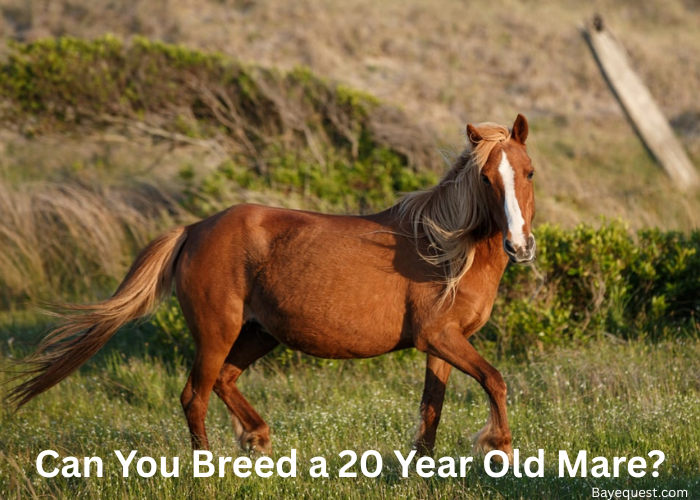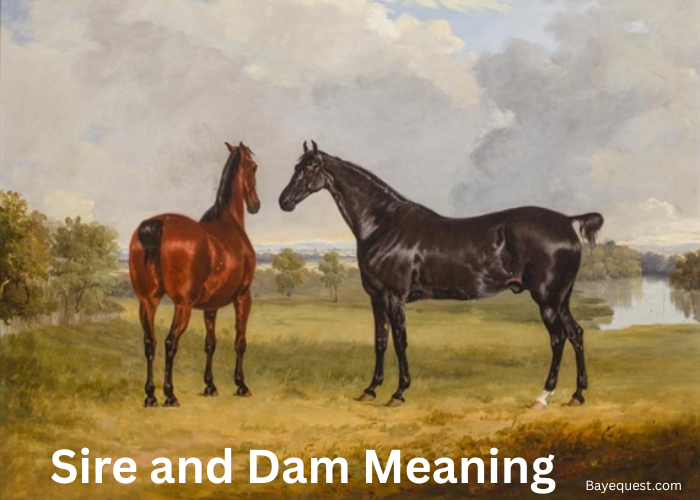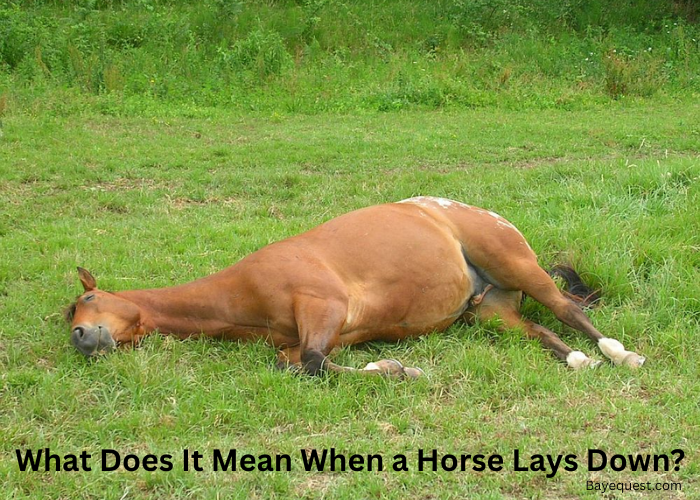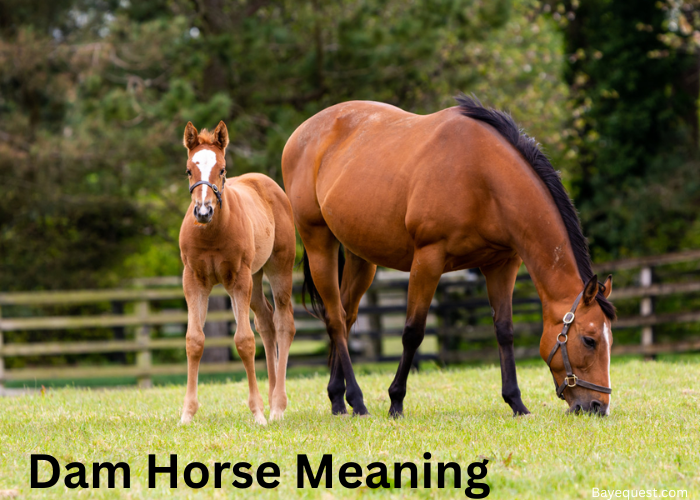Breeding a 20-year-old mare is possible, but requires thorough preparation and professional care. At this age, fertility declines, and reproductive tissues undergo changes that affect conception.
Thankfully, with proper management, many older mares can still produce healthy foals. Evaluating fertility, selecting the right stallion, and managing pregnancy encourage safe foaling.
This guide explores the key factors that determine success when breeding senior mares. Understanding these details helps owners make informed, responsible breeding decisions for senior mares.
Read on to learn more.
Can You Breed a 20 Year Old Mare? Key Takeaway
A 20-year-old mare can be bred if her health and breeding history are favorable. Many mares remain fertile into their early twenties, but conception becomes more difficult. With proper veterinary care, a healthy older mare can still produce a foal.
Understanding Mare Age and Fertility
As a mare ages, her fertility changes, as in other animals. Mares are most fertile between ages four and twelve, when cycles are regular and eggs are healthy.
After about fifteen, fertility drops as egg quality and quantity decrease.
By age twenty, the reproductive system may show signs of aging. These changes make conception and maintaining pregnancy harder.
Still, older mares can conceive and foal successfully if well managed. Proper nutrition, exercise, and veterinary care reduce age-related complications.
Younger mares with irregular cycles may struggle to conceive as much as a healthy twenty-year-old.
Reproductive Health Changes in Older Mares
As mares age, they undergo physiological changes that affect breeding success. The uterus becomes less flexible and gets less blood flow.
The cervix may become less responsive, leading to fluid retention or infection. This makes it harder to clear fluids, necessitating post-breeding uterine flushing. It also increases the risk of inflammation or infection.
Less blood flow means the embryo might not get enough oxygen and nutrients. These changes contribute to delayed conception or early pregnancy loss in older mares.
Veterinarians use uterine biopsies to judge breeding potential. A Grade I or II uterus has little to no scarring, meaning a good chance to carry a foal. Grades III and IV show extensive fibrosis, greatly reducing the chance of success.
Specialists may use uterine flushing, antibiotics, or hormone therapy to restore uterine health. Frequent reproductive exams, ultrasound tracking, and carefully timed insemination are also essential.
These steps maximize conception rates to secure a safe pregnancy in senior mares.
Read also: Steps of Breeding Horses.

Is It Safe to Breed a 20-Year-Old Mare?
Breeding a 20-year-old mare requires careful planning and professional oversight. Evaluate the mare’s reproductive system to see if it can withstand pregnancy.
A uterine biopsy can detect scarring, while hormone testing confirms normal cycling. Assessment of heart, respiratory, and metabolic function can detect infections.
A breeding mare should also have a history of successful pregnancies. These are better candidates than those attempting to conceive for the first time at that age.
With proper preparation and constant monitoring, many 20-year-old mares can have healthy foals. However, owners must remain vigilant and watch out for complications.
Advantages of Breeding an Older Mare
Breeding an older mare offers practical and genetic benefits. Senior mares bring reliability, predictability, and wisdom to the barn.
Their calm nature makes them easier to handle during breeding and pregnancy. This leads to smooth foaling and attentive motherhood, traits highly valued by breeders.
In performance breeding, older mares are valued for consistency. A 20-year-old mare with several successful foals has good fertility and strong genetics.
An older Warmblood mare that produces top dressage horses can be a great asset to a breeding program. This gives breeders confidence when planning for future foals that meet competition goals.
Older mares also play an important role as teachers. Their calm temperament helps younger horses in the barn or pasture learn how to behave.
Foals from mature mares are easier to train and more confident as they grow.
Disadvantages and Risks of Breeding Senior Mares
Even with these benefits, breeding older mares comes with challenges. They risk facing birth complications, such as weak contractions and prolonged labor.
Their fertility drops, and it may take several tries to get them pregnant. Additionally, early embryo loss is more common in aging mares.
As mares age, their reproductive tissues change, making it harder to keep a pregnancy. Scarring or fluid in the uterus can prevent implantation.
Furthermore, hormone changes can cause irregular cycles. Older mares may have trouble passing the placenta, increasing the risk of infections.
Caring for an older broodmare can also get expensive. Vet visits, special feed, and treatments add up, and not every breeding will result in a foal. The cost-to-benefit ratio should prompt you to reconsider your breeding plans.
Breeding older mares is possible, but it requires careful management. Be prepared for both positive outcomes and setbacks.
Health Preparation Before Breeding an Older Mare
Preparing an older mare for breeding starts long before the actual attempt. Ideally, prepare months in advance to allow time for health improvements and treatments.
A complete veterinary exam is the foundation. A vet should assess the mare’s heart, lungs, and joints to ensure she can handle pregnancy.
Ultrasounds, uterine cultures, and biopsies can identify infections that may hinder implantation. Hormone testing also confirms whether her cycles remain regular.
Nutrition is equally important. Older mares have slower metabolisms and may have trouble keeping a healthy weight.
Provide high-quality hay or pasture, along with mineral supplements, to support reproductive health.
Choosing the Right Stallion for an Older Mare
Picking the right stallion can help an older mare get pregnant. Choose a fertile stallion with strong semen, especially if you use artificial insemination.
Mobile semen offers a better chance of conception when the mare’s uterus is less receptive.
Consider the horse’s genetics, too. Avoid stallions that tend to produce big foals if your mare has a narrow pelvis. This increases complications, making parturition harder.
Work with an expert to match mares and stallions based on physical and genetic traits. This lowers risks and increases the chances of a successful pregnancy.

Pregnancy Care for a 20-Year-Old Mare
Caring for a pregnant 20-year-old mare involves careful management and regular vet visits. Older mares can bear healthy foals, but their pregnancies are often more delicate.
The vet should attend to expectant mares from conception to birth. Ultrasounds, usually at 14, 30, and 60 days, ensure the embryo is growing well. Later checkups can detect problems such as a thickened placenta, excess fluid, or stress signs.
Nutritional requirements increase as the pregnancy progresses. In the last three months, the mare needs more energy, protein, and calcium because the foal is growing fast.
Provide good hay, such as alfalfa, and supplement with copper, zinc, selenium, and vitamin E.
Quality nutrition helps the foal develop and keeps the mare healthy. Don’t overfeed the horse, as extra weight can stress the mare’s joints and circulation.
Careful monitoring and quick response to issues ensure safe foaling and timely recovery.
Foaling Considerations for Senior Mares
Foaling is often tougher for older mares, so it is important to prepare adequately. Make sure the foaling area is clean, bright, and safe. Older mares may have weaker contractions and might need help during birth.
After foaling, watch for medical emergencies like a retained placenta or heavy bleeding. The foal should stand and nurse within two hours, and it’s important to test the mare’s colostrum for quality.
Older mares may take longer to recover post parturition. Provide a quiet place and gentle turnout to help them regain their strength.
Even with the risks, many older mares raise healthy foals every year. This shows careful management can overcome the challenges of age.
Alternatives to Natural Breeding
If pregnancy is too risky for an older mare, there are safe ways for her to pass on her genetics. Here are some common alternatives;
Embryo Transfer
In this process, the mare is inseminated, and the embryo is collected after seven days. The fertilized embryo is then transferred into a younger, healthy mare.
The recipient mare carries the pregnancy to term. This technique preserves valuable bloodlines while protecting the donor mare’s well-being.
Oocyte Transfer
Sometimes, senior mares continue producing viable eggs but cannot sustain pregnancy. In this case, her oocytes are retrieved and fertilized in a lab.
The fertilized embryo is then implanted into a recipient mare. This approach is common in mares with uterine scarring or age-related complications.
Using Surrogates or Foster Mares
Breeders use foster mares to nurse foals if the older mare can’t produce sufficient milk. Surrogates ensure the foal receives the nutrition and care needed to thrive.
Improved Reproductive Technology for Older Mares
Advances in horse reproduction have changed how breeders work with older mares.
Oocyte Recovery and In-Vitro Fertilization
Veterinarians can retrieve eggs from the mare’s follicles and fertilize them. The resulting embryos are transferred to surrogates.
The older mare can pass her genes, without having to carry a foal herself.
Embryo Vitrification
This technique freezes embryos for future use without damaging their structure. Owners can plan breeding programs in advance or wait for the ideal surrogate mare.
Cell Line Processing
In some cases, genetic material can be preserved for later cloning or research. This helps to sustain rare or exceptional bloodlines.
This technology helps breeders maintain important bloodlines while lowering risks for older mares.

When Not to Breed an Older Mare
Sometimes, breeding an older mare is not a good idea. If she has ongoing issues like arthritis or metabolic disease, pregnancy may be too risky.
Avoid breeding mares with uterine fibrosis, recurring infections, or repeated early embryo loss. A mare that hasn’t foaled in over five years faces lower fertility and higher complications.
In these cases, prioritize the mare’s long-term health and comfort. Alternatively, adopt modern reproductive techniques to preserve her genetics.
When Is a Mare Too Old to Breed?
The practical upper limit for breeding is 24-25 years, though exceptions exist. The oldest foaling mares have been 26 or 27, but they required advanced management.
Breeding decisions should be based on a vet’s assessment and the mare’s reproductive health. If there are concerns about her condition, consider assisted reproduction.
Similarly, retiring her from breeding is the kindest and most responsible choice.
FAQs
Can a 20-year-old horse have a baby?
Yes. Many 20-year-old mares can still conceive and deliver healthy foals if managed correctly. Ensure the mare’s uterus and health condition are sound thorough veterinary assessment. With proper nutrition and careful monitoring during gestation, older mares often foal successfully. However, conception may take more than one breeding cycle.
What are the risks of breeding an older mare?
Breeding older mares poses risks like lower fertility, embryonic loss, and foaling complications. Uterine scarring, fluid retention, and weak contractions are common concerns. Postpartum issues, such as retained placenta or infection, may also arise. Diligent veterinary supervision, hormone management, and timely interventions can reduce complications.
At what age should you stop breeding mares?
Most breeders retire mares from breeding around 20 to 23 years old. However, this may vary depending on their health and reproductive performance. After this age, uterine quality and egg viability decline, raising the chance of miscarriage. Mares with valuable genetics are bred using assisted reproductive technologies. Strategies like embryo transfer allow safe genetic preservation without physical strain.
How late in the year can you breed a mare?
From early spring to midsummer, natural light stimulates regular heat cycles. This is the ideal window for breeding a mare. Breeding too late into the season can result in foals arriving during colder months. This increases the risk of illness and stunted growth. Breeders use artificial lighting to synchronize cycles and improve timing for optimal foaling.
Conclusion
Determining when a mare is too old to breed depends on her health, fertility, and breeding history. While some mares remain capable into their twenties, others face heightened risks.
Veterinary assessment is crucial before making any decision. Responsible breeders prioritize the mare’s comfort and long-term well-being over another foal.
With careful planning and expert oversight, senior mares can contribute to the breeding program. Modern technology enables breeders to pass down desirable traits from aging mares.








